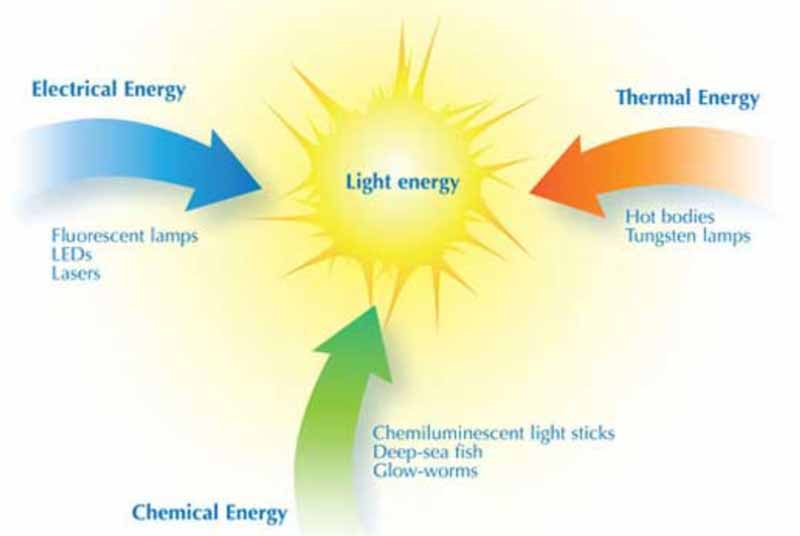The concept of light energy is fundamental in various scientific disciplines, particularly in physics and environmental science. Light energy, a form of electromagnetic radiation, plays an essential role in processes ranging from photosynthesis in plants to the generation of electricity in solar panels. Understanding the sources of light energy is crucial for both theoretical research and practical applications. This exploration delineates the distinguishing categories of sources while examining their roles and mechanisms.
1. Natural Sources of Light Energy
Natural sources of light energy are predominantly celestial and geological phenomena that emit or reflect light. The sun stands as the paramount source of light energy for Earth. As a massive nuclear fusion reactor, it emits an astonishing amount of energy across the electromagnetic spectrum, with visible light being a mere fraction of its emission.
Much of the light energy received from the sun is harnessed by various ecosystems through the process of photosynthesis. Plants convert sunlight into chemical energy, which sustains not only them but also the entire food chain. Solar energy, thus, is the keystone of energy flow in natural ecosystems.
Aside from solar energy, other natural sources include fire and bioluminescence. Fire generates light through combustion, a chemical process that releases energy stored in organic materials. Bioluminescence, found in certain species of fungi, insects, and marine organisms, is a remarkable biological process where chemical reactions in living cells produce light. These natural pathways contribute significantly to the illumination of our surroundings and the sustenance of life.
2. Artificial Sources of Light Energy
Artificial sources of light energy are created by human ingenuity, allowing us to generate light in a controlled and efficient manner. The advent of the electric bulb marked a revolution in the way we perceive and utilize light energy. Incandescent bulbs produce light through the heating of a filament, while fluorescent and LED (light-emitting diode) technologies utilize more sophisticated mechanisms.
Fluorescent lights work by exciting gas molecules to emit ultraviolet light, which then causes a phosphor coating inside the bulb to glow. This method is significantly more energy-efficient than incandescent bulbs, leading to widespread adoption in commercial and residential settings. LEDs represent the cutting edge of artificial light, converting electrical energy directly into visible light with minimal heat production. Their longevity and efficiency have made them the preferred choice in modern lighting solutions.
Furthermore, laser technology epitomizes an advanced form of artificial light energy. Lasers produce coherent light through stimulated emission, yielding focused beams that find applications in medicine, telecommunications, and manufacturing. The unique ability of lasers to manipulate light energy has revolutionized various fields, augmenting precision and functionality.
3. Electromagnetic Spectrum: Understanding Light Energy
To thoroughly decipher the sources of light energy, one must delve into the electromagnetic spectrum (EMS). This continuum encompasses a range of wavelengths, from short gamma rays to long radio waves. Light energy is primarily associated with the visible portion of the EMS, although many sources emit energy outside this spectrum.
For instance, ultraviolet (UV) light, sourced from the sun, is responsible for a range of effects, such as Vitamin D synthesis in skin and the degradation of materials through photolysis. Similarly, infrared radiation, another subset of electromagnetic energy, is generated by thermal sources and is instrumental in applications such as thermal imaging and night vision.
Understanding the full breadth of the electromagnetic spectrum enables a richer comprehension of how various sources contribute to our experience and utilization of light energy. The interplay between different wavelengths can create innovative solutions, especially in fields such as photonics and optical communications.
4. The Role of Technology in Harnessing Light Energy
The increasing demand for renewable energy has sparked significant advancements in technologies designed to harness light energy. Photovoltaics (PV) exemplify this shift towards sustainability. PV cells, commonly used in solar panels, convert sunlight directly into electricity via the photovoltaic effect. This process involves semiconductor materials that generate a flow of electric current when exposed to light.
In addition to solar panels, concentrated solar power (CSP) utilizes mirrors or lenses to focus a large area of sunlight, generating heat that can produce steam to drive turbines for electricity generation. This method underscores the innovative approaches being implemented to maximize the potential of solar energy on a larger scale.
5. The Future of Light Energy Sources
As the global energy landscape evolves, the pursuit of alternative light energy sources has gained prominence. Research into bio-inspired systems mimicking photosynthetic processes provides exciting possibilities for the future. Artificial photosynthesis aims to replicate the natural process of converting sunlight, water, and carbon dioxide into energy-rich compounds.
Moreover, advancements in nanotechnology may allow for the development of ultrathin solar cells with enhanced efficiency and adaptability. Such innovations could pave the way for even greater integration of light energy into our daily lives, further diminishing humanity’s carbon footprint and fostering an eco-friendly future.
Conclusion
The exploration of light energy sources encompasses a vast array of natural and artificial phenomena, each contributing uniquely to our understanding and application of energy. From the sun, which sustains life on Earth, to cutting-edge technologies designed to harvest energy efficiently, the spectrum of light energy is both diverse and vital. As research progresses and innovations emerge, the significance of understanding these sources will only deepen, empowering humanity to harness energy sustainably and responsibly.












